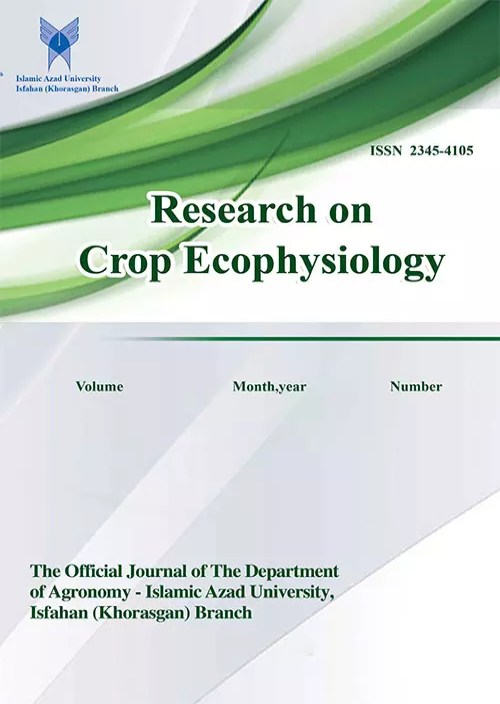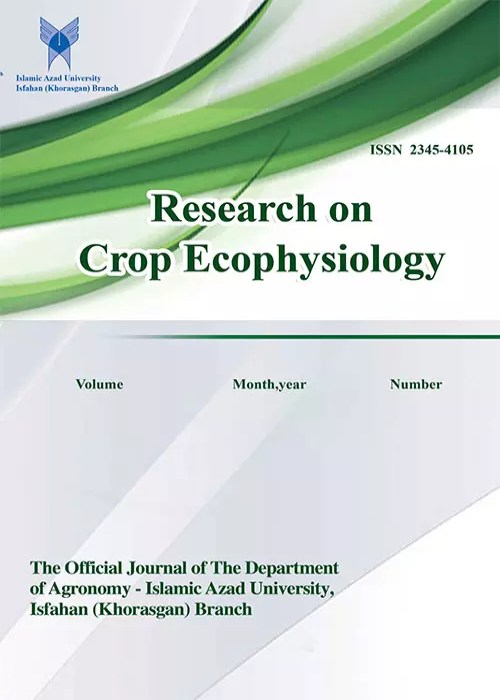فهرست مطالب

Journal of Research on Crop Ecophysiology
Volume:15 Issue: 2, Spring 2020
- تاریخ انتشار: 1401/11/08
- تعداد عناوین: 6
-
Pages 63-68
In order to identify the plant parasitic nematodes of potato fields in Western and central regions of Isfahan province, 45 soil and root samples were collected from rhizosphere and aerial parts of potatoes during 2018 and 2019. The nematodes were extracted by combined sieving and centrifugal-flotation method of Jenkins and transferred to glycerin by using DeGrisse method. The permanent slides were prepared and the nematodes were studied by light microscopy. In this research, 20 species from nineteen genera belonging to Tylenchina and Aphelenchina suborders were identified as follows: Amplelimerlinius sp., Aphelenchoides limberi, Aphelenchus avenae, Boleodorous thylactus, Ditylenchus destructor, Filenchus filiformis, Filenchus polyhypnus, Haplolaimus galeatus, Helicotylenchus vulgaris, Irantylenchus sp., Merlinius brevidens, Neopsilenchus magnidens, Paratylenchus similis, Pratylenchoides ritteri, Pratylenchus neglectus, Psilenchus iranicus, Rotylenchus iranicus, Scutylenchus rugosus, Tylenchus davainei, Zygotylenchus guevarai. The species Helicotylenchus vulgaris, and Irantylenchus sp. were measured with 58 and 2 percent frequency, respectively. In this research, the asterisk species were the new records for potato nematode fauna of Isfahan province.
Keywords: Irantylenchus sp. Plant parasitic nematode, Potato -
Pages 70-75
The aim of this investigation was to studies Orius wolff (Het. Anthocoridae) and Coccinellidae species present in localities in Isfahan region, Iran. Samples were taken from Corn fields and the material screened in laboratory. External characters plus characters of the male and female genitalia were used in order to giagnose Orius and Coccinellidae species. Five Orius species were sampled on Corns: Orius albidipennis, O. niger niger, O. niger aegyptaicus, Orius vicinus, Orius horvathi, O. horvathi were reported for the first time in Isfahan, Iran. Coccinellids species were identified on maize and collected as following: Coccinella septempunctata, Coccinella undecimpunctata, Hipodamia variegate, Oenopia conglobate, Propylea quatuordecimpunctata; Hyperaspis syriaca. Identification of insect species with biological control potential has important role in their use for the production of healthy crops.
Keywords: Coccinellid, Orius, predators, Corn. Biological control -
Pages 77-85
Early blight disease (caused by Alternaria alternata (Fr.) Keissler) is one of the most important potato diseases around the world which causes the death of the leaf tissues and sharp decrease in the final yield. Identifying and using resistant potato cultivars is one of the effective methods to deal with this disease. In the current study, the resistance of 46 potato genotypes (including 24 genotypes of Isfahan and 22 common genotypes of Isfahan and Shahrood) were investigated in the field by evaluating the severity of the disease in six levels from 0 to 6 (0-100%). The results showed that there were significant differences between the resistances of different potato genotypes. Three resistant genotypes (R1/33/10, R2/33/3 and R2/33/21) and three sensitive genotypes (8707/106, 8703/804 and 8707/112) were selected to investigate the changes of plant biomass and were inoculated with the spores of the disease-causing fungus (106) in the greenhouse. Biomass parameters showed significant decrease compared to the control samples. The amount of this decrease was much higher in sensitive genotypes than resistant genotypes. The knowledge obtained from this study can be useful for the production of disease-resistant potato cultivars.
Keywords: Resistance, Disease severity, genetic diversity, biomass -
Pages 87-95
Tomato is one of the great importance in terms of the worldwide consumption of nutritional regimes. The present study investigated the effects of macro (75, 150 and 300 kg NPK ha-1) and micro-nutrients (0 zinc and 0 boron, 2 Zn and 2 B and 4 Zn and 4 B kg ha-1) with plant shading (shading and non-shading) in tomato cropping systems. The results showed that application of 150 kg NPK ha-1 with shading produced 43.11 g fruit weight per plant and the lowest fruit weight (5.66 gr fruit weight per plant) obtained in 75 kg NPK ha-1. The combination of micronutrients and macronutrients with shading had significant effects on plant height. Among studied treatments just micronutrients significantly affected brix index. Highest plant height obtained at 150kg/ha NPK and also 4kg/ha Zn and B resulted to highest plant height. The results obtained from this experiment strongly support this idea of improving the growth and yield of tomatoes by provision of balanced amount of nutrients.
Keywords: Essential nutrients, Shading, Tomato, Zinc -
Pages 97-109
Agaricus bisporus is the most produced mushroom in the world due to its unique taste and valuable nutritional properties. For this purpose, a study in the form of a completely randomized design with 5 treatments and 3 repetitions was conducted, which includes (control) (chitosan 2%) (chitosan 2% + cinnamon essence 2%) (chitosan 2% + angelica essence with a concentration of 200 ppm) (chitosan 2% + cinnamon essence 2% + angelica essence with a concentration of 200 ppm). The properties of Agaricus bisporus were evaluated on days 0, 7, 14, and 21. The results indicated 7 and 14 days after storage, chitosan casing as well as chitosan essence + angelica and cinnamon essence increased the phenolic acid content compared to the control and zero days after storage. On the 7th, 14th, and 21st days after storage, chitosan + angelica treatment showed the highest weight loss. The lowest weight loss was observed 21 days after storage in control and chitosan treatment. The highest number of soluble solids was observed 7 days after storage in chitosan + angelica essence and chitosan + cinnamon essence. The highest color index L* was observed at zero days after storage in the control treatment. The highest color index a* was observed on the 14th day of storage in the chitosan + angelica + cinnamon treatment and on the 7th day of storage in the chitosan treatment. The lowest color index a* was obtained on the 14th day of storage in the chitosan + cinnamon treatment and on the 7th day of storage in the chitosan + angelica + cinnamon and chitosan + cinnamon treatments. The highest b* color index was observed in the control treatment at 21 days after storage. In general, treatments showed different results on biochemical properties and post-harvest shelf life of Agaricus bisporus.
Keywords: Chitosan, Essential oil, Edible mushroom, soluble solids -
Pages 111-115
Plutella xylostella L. which known as diamondback moth, is one of the most destructive pests of Brassica crops and causes qualitative and quantitative decrease of yield. Because of high reproductive rate, high capability of immigration and being resistance to many groups of insecticides, the control of this pests is difficult. Application of sex pheromone-baited traps is effectiveness non chemical methods to management of P. xylostella worldwide. This study was investigated the efficiency of color and height of pheromone traps on attraction of P. xylostella male moth in randomized complete block design with six treatments (yellow, green and transparent color with 70 and 120 cm height) with four replications. The results revealed that yellow trap with mean of 94.6 had the highest effect of moth attraction, and transparent traps with mean of 9.2 had the least P. xylostella trapping. In two different height of trap assay, the pheromone traps in 70 cm height had the greatest ability to attract the moth with mean of 55.7 insect. According to the results, the yellow pheromone trap at a height of 70 cm has the greatest effect in attracting the male species of the diamondback moth in cauliflower fields, which can be used to control of this pest.
Keywords: Cauliflower, Diamond back moth, pheromone trap, sex pheromone


